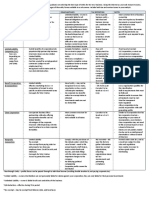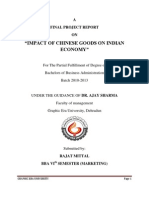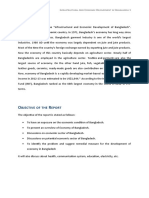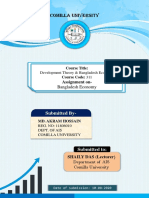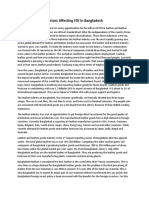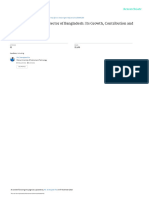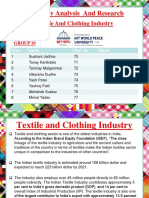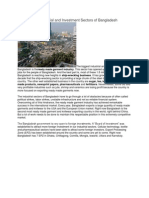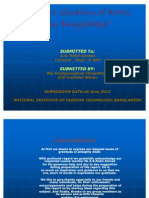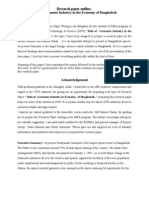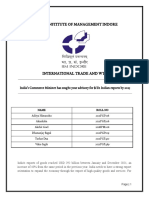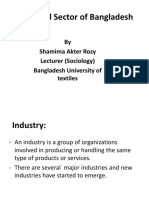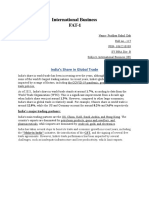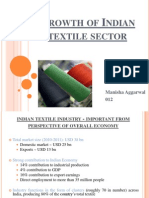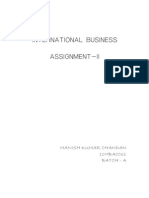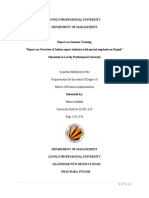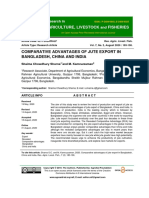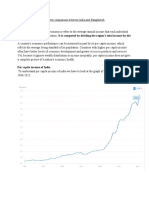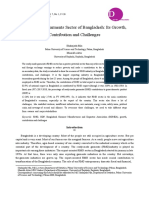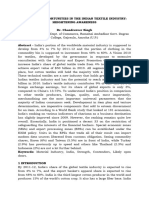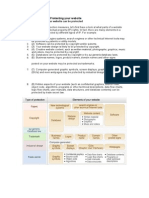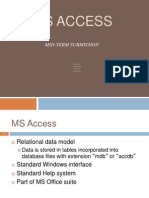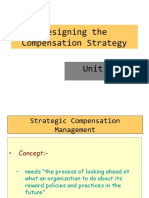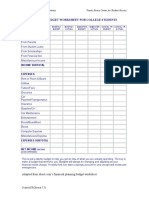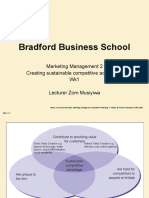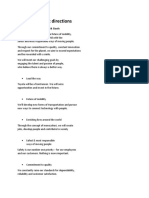100%(1)100% found this document useful (1 vote)
25 viewsFashion Export Merchandising & Exim Documentation: National Institute of Fashion Technology, Hyderabad
Fashion Export Merchandising & Exim Documentation: National Institute of Fashion Technology, Hyderabad
Uploaded by
agga1111The document discusses Bangladesh's export and import industry. It provides background on Bangladesh including its population, GDP, major cities, and climate. It then outlines Bangladesh's main export commodities which are ready-made garments, frozen food, agricultural products, and leather goods. The major import goods include oil, wheat, and machinery. Key export partners are USA, EU, and India, while main import partners are China, India, and South Korea. The document concludes by noting that while Bangladesh has advantages in labor costs and exports, India has stronger ties to key markets and produces a more diverse range of goods.
Copyright:
© All Rights Reserved
Available Formats
Download as PPTX, PDF, TXT or read online from Scribd
Fashion Export Merchandising & Exim Documentation: National Institute of Fashion Technology, Hyderabad
Fashion Export Merchandising & Exim Documentation: National Institute of Fashion Technology, Hyderabad
Uploaded by
agga1111100%(1)100% found this document useful (1 vote)
25 views22 pagesThe document discusses Bangladesh's export and import industry. It provides background on Bangladesh including its population, GDP, major cities, and climate. It then outlines Bangladesh's main export commodities which are ready-made garments, frozen food, agricultural products, and leather goods. The major import goods include oil, wheat, and machinery. Key export partners are USA, EU, and India, while main import partners are China, India, and South Korea. The document concludes by noting that while Bangladesh has advantages in labor costs and exports, India has stronger ties to key markets and produces a more diverse range of goods.
Original Description:
opp
Original Title
Fexm Group 3 Final-2
Copyright
© © All Rights Reserved
Available Formats
PPTX, PDF, TXT or read online from Scribd
Share this document
Did you find this document useful?
Is this content inappropriate?
The document discusses Bangladesh's export and import industry. It provides background on Bangladesh including its population, GDP, major cities, and climate. It then outlines Bangladesh's main export commodities which are ready-made garments, frozen food, agricultural products, and leather goods. The major import goods include oil, wheat, and machinery. Key export partners are USA, EU, and India, while main import partners are China, India, and South Korea. The document concludes by noting that while Bangladesh has advantages in labor costs and exports, India has stronger ties to key markets and produces a more diverse range of goods.
Copyright:
© All Rights Reserved
Available Formats
Download as PPTX, PDF, TXT or read online from Scribd
Download as pptx, pdf, or txt
100%(1)100% found this document useful (1 vote)
25 views22 pagesFashion Export Merchandising & Exim Documentation: National Institute of Fashion Technology, Hyderabad
Fashion Export Merchandising & Exim Documentation: National Institute of Fashion Technology, Hyderabad
Uploaded by
agga1111The document discusses Bangladesh's export and import industry. It provides background on Bangladesh including its population, GDP, major cities, and climate. It then outlines Bangladesh's main export commodities which are ready-made garments, frozen food, agricultural products, and leather goods. The major import goods include oil, wheat, and machinery. Key export partners are USA, EU, and India, while main import partners are China, India, and South Korea. The document concludes by noting that while Bangladesh has advantages in labor costs and exports, India has stronger ties to key markets and produces a more diverse range of goods.
Copyright:
© All Rights Reserved
Available Formats
Download as PPTX, PDF, TXT or read online from Scribd
Download as pptx, pdf, or txt
You are on page 1of 22
National Institute Of Fashion Technology, Hyderabad
Fashion Export Merchandising & Exim
Documentation
OUTLINE
INTRODUCTION
BANGLADESH AT A GLANCE
EXPORT-IMPORT COMMODITIES
EXPORT IMPORT PARTNERS
PRESENT EXPORT SCENARIO
SWOT ANALYSIS
RECOMMENDATIONS
IMPORTANCE FOR INDIA IN TERMS OF EXPORTS
CONCLUSION
INTRODUCTION
Bangladesh emerged as an
independent Country in 1971.
Bordered on India by 3 sides
and by Myanmar on south-
east.
8th largest populous country in
the world.
Size of the country is 147570 sq.
kilometers.
160.4 million people with
1.27% growth rate.
Small country with huge HR:
More than 64 million labor
force.
BANGLADESH AT A GLANCE
Capital: Dhaka;
Other major cities: Chittagong,
Khulna, Sylhet, Rajshahi, Barisal
& Rangpur
Climate: Sub-tropical monsoon
Temperature: Average
maximum 35C and minimum
21C
Major language: Bengali,
English is generally understood
Adult Literacy Rate: 64% (15
years +)
Currency: Taka
GDP per capita: US$
1700(2010)
International Air Ports :
Dhaka. Chittagong, Sylhet
Sea Ports : Chittagong and
Mongla
Investment climate: Conducive
investment climate compared to
other South Asian countries.
EXPORT ~ IMPORT COMMODITIES
Export:
RMG (Woven & Knit)
Frozen food (shrimp)
Agricultural products
Leather & leather products
Jute goods
Engineering goods
Ceramics
Home Textile
Textile fabrics etc
Import:
Oil
Edible oil
Petroleum products
Wheat
Seeds
Fertilizer
Yarn
Capital goods
Machinery
Scientific & medical
equipments.
EXPORT ~ IMPORT PARTNERS
Export:
USA
EU
Canada
Turkey
Japan
Australia
India
China
South Korea etc.
Import:
China
India
Singapore
Japan
Malaysia
South Korea
Germany
Middle-east
Uzbekistan etc.
PRESENT EXPORT SCENARIO
Bangladesh is exporting 705 products to the global market.
Share of major export products are -
01 RMG and knit wear 78.13%
6 Items
02 Jute goods 3.30%
03 Frozen Foods 2.73%
04 Raw Jute 1.56%
05
Leather & Leather
Products
1.54%
06 Footwear 1.30%
Total 88.56%
Only 6 commodities are contributing 88.56 % to our total export earning
where as 699 items have share of 11.44 % in our total export.
SWOT ANALYSIS
OF BANGLADESH
Advantage over China, Pakistan & India
Adequate supply of labor force of both sexes, attributed with less
attitudes problem (less absenteeism and, aptitude for learning, and
loyal) and high morale
Cheaper labor cost
Low cost of captive power generation using gas as fuel
GSP facility up to 2015 (renewed recently)
STRENGTHS
Bangladesh produce mostly basic products- which are low cost items; the share of fashion
products i.e., high value added product is very low.
Bangladesh does not produce the basic raw materials (only a negligible quantity of cotton
but no manufactured fiber) and as such has to depend totally on sensitive global market.
Because of inadequate backward linkage, lead-time happens to be long, nearly 3
months.
Public power supply is erratic.
Bank interest rate is still high enough, particularly of private sector bank, for investment
of export oriented high value project.
HRD facility, productivity and quality support, testing and accreditation support, design
support and compliances are yet to be enhanced.
Cost of doing business is high because of under table money
WEAKNESSES
Bangladesh has now a scope to go for more fashion oriented products
deserving high price in the global market.
With the help of further increase of productivity & quality and design
support, Bangladesh can minimize cost and maximize profit and export
value.
Bangladesh, as a proven experienced RMG & Textile manufacturer, can
expand share in the existing market (USA, EU, Australia, Canada, etc.) and
can also explore opportunity in Japan & CIS countries.
In the long run, Bangladesh has a scope to target huge populated countries like
China and India- where demand as well as cost of manufacturing will be wider.
OPPORTUNITIES
Unless new strong market is explored in home or abroad, any non-cooperation
from USA & EU may jeopardize the whole Bangladesh RMG export business and
consequently the textile manufacturing.
Sudden price hike of cotton and yarn in the global market may push
Bangladesh to a very awkward situation to devastate the business.
The type of labor and political anarchies of the recent days if prevails in
the future, Bangladesh may lose the business in the way Sri Lanka has
lost.
Growing terrorism, or its false/amplified propaganda, is also a big threat.
The poor political culture and violence is one of the most important threats.
(Source: http://forum.daffodilvarsity.edu.bd/index.php?topic=5141.0)
THREATS
Bangladesh has to create new capacities and modernize & balance
the existing ones.
Encouragement of FDI from ethnic Bengalis in foreign countries
would be one of the best options for the needed financing in
addition to the local banks' efforts.
Power supply has to be ensured.
Bangladesh needs to develop capacities to provide the industries
with a sustainable supply of resource personnel and support
services in regard of research, design, testing & standardization,
accreditation, compliances, etc.
RECOMMENDATIONS:
Bangladesh to improve its situation
Bangladesh has to improve the port efficiency further and gear up
domestic transportation.
Labor crisis, labor safety, social rights and gender issues have to be
dealt with more efficacies.
It is important that the buyers should have a preferred access to the
country; starting from reception on arrival to facilities such as
hotel/rest house, tourism and recreation should be improved.
IMPORTANCE FOR INDIA
IN TERMS OF EXPORTS
WEAKNESS VIEWPOINT
India produces all types of high, mid and low cost items and the pool of
textiles India produces almost covers every kind of need in the market.
India happens to be a hub of textiles and raw material majorly Tirupur
for its knits, Bhagalpur for its silk and Cotton in many states like
Gujarat, Andhra Pradesh, Punjab, etc.
India has been exporting since many years now, the lead times here are
lower comparatively.
OPPORTUNITY VIEWPOINT
Bangladesh has now a scope to go for more fashion oriented
products. India, being closest in terms of distance will have
higher exports of raw material and high cost fabrics to
Bangladesh.
India has strong ties with US and European countries, hence,
Bangladesh focusing on big countries shall face tough
competition from India.
THREAT VIEWPOINT
If the political situation doesnt improve, Bangladesh
shall increase imports from India, so that the labor
doesnt face unemployment.
West Bengal becomes the highest source of
material and labor exchange during power and labor
crisis.
CONCLUSION
India's exports have grown much faster than GDP over the past few
decades. In the past, its exports have grown over 11% per annum
while growth in GDP is about 5% during 1970-98 periods. Exports
have grown even faster since 1945-95. Several factors appear to
have contributed to this phenomenon including foreign direct
investment (FDI)which has been rising consistently especially from
the early 1990s.
India and Bangladesh are in bilateral trade relationship. Whereas,
Bangladesh has its advantages in exports, India has a major chunk
of merits over Bangladesh in reaction to many of the threats and
weaknesses Bangladesh has.
REFERENCES
1. http://forum.daffodilvarsity.edu.bd/index.php?topic=5141.0
2. http://web.worldbank.org/WBSITE/EXTERNAL/COUNTRIES/
SOUTHASIAEXT/0,,contentMDK:21177520~pagePK:146736~
piPK:146830~theSitePK:223547,00.html
3. http://shodhganga.inflibnet.ac.in/bitstream/10603/1169/14/
14_chapter%207.pdf
4. http://aida.wss.yale.edu/growth_pdf/cdp816.pdf
THANK YOU
You might also like
- Jewelry Manufacturing ProcessDocument8 pagesJewelry Manufacturing Processagga1111No ratings yet
- Ratio Analysis of WalmartDocument31 pagesRatio Analysis of Walmartagga1111100% (2)
- Jewelry Manufacturing ProcessDocument8 pagesJewelry Manufacturing Processagga1111No ratings yet
- Assignment - Chapter 2 - Research Problem 1 (Due 09.20.20)Document1 pageAssignment - Chapter 2 - Research Problem 1 (Due 09.20.20)Tenaj KramNo ratings yet
- Impact of Chinese Goods On Indian EconomyDocument46 pagesImpact of Chinese Goods On Indian EconomyRajat Mittal100% (2)
- National Institute of Fashion Technology: Report On Supply Chain Practices OFDocument19 pagesNational Institute of Fashion Technology: Report On Supply Chain Practices OFagga1111No ratings yet
- Black BookDocument23 pagesBlack BookVikas Tiwari44% (9)
- SWOT Analysis of Bangladesh TextileDocument1 pageSWOT Analysis of Bangladesh Textileforqan87No ratings yet
- Swot Analysis of Apparel Export Business For Bangladesh With Respect To IndiaDocument15 pagesSwot Analysis of Apparel Export Business For Bangladesh With Respect To IndiaGovindasamy ArumugamNo ratings yet
- FDI Investment in BangladeshDocument42 pagesFDI Investment in BangladeshAbdullah Al MamunNo ratings yet
- Executive Summar1Document13 pagesExecutive Summar1Tazul IslamNo ratings yet
- Inb 304Document10 pagesInb 304Rebaka Alam KhanNo ratings yet
- Southeast University: Department of Textile EngineeringDocument16 pagesSoutheast University: Department of Textile EngineeringHarunur RashidNo ratings yet
- Tram PaperDocument41 pagesTram PaperWalid HasanNo ratings yet
- HRM360 ReportDocument29 pagesHRM360 ReportMoshiur R. PrinceNo ratings yet
- Cost of Doing Business in BangladeshDocument5 pagesCost of Doing Business in BangladeshRokan uddinNo ratings yet
- Chapter 3-Asssignment 2Document21 pagesChapter 3-Asssignment 2shaily DasNo ratings yet
- Leather Industry of BangladeshDocument7 pagesLeather Industry of BangladeshAheen ImtiazNo ratings yet
- Business Analysis of Readymade Garments Industry in Context of Complex Strategic Environment of BangladeshDocument31 pagesBusiness Analysis of Readymade Garments Industry in Context of Complex Strategic Environment of BangladeshSaeed DogarNo ratings yet
- Factors Affecting FDI in Bangladesh OutflowsDocument3 pagesFactors Affecting FDI in Bangladesh OutflowsNazneen Islam JabeenNo ratings yet
- RMG Sector in BangladeshDocument13 pagesRMG Sector in BangladeshmukhostanuNo ratings yet
- RMGPaperDocument11 pagesRMGPapershovan KamalNo ratings yet
- Industry Analysis and ResearchDocument22 pagesIndustry Analysis and ResearchMrinal Hashishin YadavNo ratings yet
- Term Papernon Aarong's Strategic ManagementDocument33 pagesTerm Papernon Aarong's Strategic ManagementFarhan FuadNo ratings yet
- Internationalization of Bangladeshi CompaniesDocument14 pagesInternationalization of Bangladeshi CompaniesAulad Hossain100% (2)
- Final Term Paper RMG Industry of BangladeshDocument15 pagesFinal Term Paper RMG Industry of BangladeshtaijulshadinNo ratings yet
- The Industrial and Investment Sectors of BangladeshDocument1 pageThe Industrial and Investment Sectors of BangladeshShafiqul Islam ShehabNo ratings yet
- Present Situation of RMG Sector of BangladeshDocument25 pagesPresent Situation of RMG Sector of BangladeshWares Pavel50% (4)
- 1st Part AweDocument28 pages1st Part Aweuitsmba700No ratings yet
- InvestIndia - PLI Textiles - VFDocument44 pagesInvestIndia - PLI Textiles - VFTushar JoshiNo ratings yet
- Indian Institute of Management Indore: India's Commerce Minister Has Sought Your Advisory For $1Tn Indian Exports by 2025Document4 pagesIndian Institute of Management Indore: India's Commerce Minister Has Sought Your Advisory For $1Tn Indian Exports by 2025Vaibhav SinghNo ratings yet
- Industrial Sector in BDDocument30 pagesIndustrial Sector in BDImtiaz AhmedNo ratings yet
- "Diversification of Export in Bangladesh": Assignment OnDocument12 pages"Diversification of Export in Bangladesh": Assignment OnTamara Dilruba AliNo ratings yet
- Bangladesh - The Digital Delta - LightCastle Partners PDFDocument17 pagesBangladesh - The Digital Delta - LightCastle Partners PDFHashmi RafsanjaniNo ratings yet
- Assignment: Bangladesh's RMG On Global Business.: Submitted By: Md. Nasrath Faisal (1210914)Document5 pagesAssignment: Bangladesh's RMG On Global Business.: Submitted By: Md. Nasrath Faisal (1210914)NasrathFaisalNo ratings yet
- Noakhali Science & Technology UniversityDocument11 pagesNoakhali Science & Technology UniversityRaisul AlamNo ratings yet
- 117 - Ib Fat 1Document5 pages117 - Ib Fat 1Pushkar OakNo ratings yet
- Is Import Substitution And/or Export Led Growth Strategy Necessary For The Economic Development of Bangladesh? Provide Your Answer With ArgumentsDocument5 pagesIs Import Substitution And/or Export Led Growth Strategy Necessary For The Economic Development of Bangladesh? Provide Your Answer With ArgumentsAmirat HossainNo ratings yet
- Rowth OF Ndian Textile Sector: Manisha Aggarwal 012Document12 pagesRowth OF Ndian Textile Sector: Manisha Aggarwal 012jeet_singh_deepNo ratings yet
- International Business Assignment-Ii: C C C C C C C C C C CDocument6 pagesInternational Business Assignment-Ii: C C C C C C C C C C CManish SharmaNo ratings yet
- Ready Made Garments Industry in BangladeshDocument46 pagesReady Made Garments Industry in Bangladeshnahidul202No ratings yet
- Export IndustryDocument43 pagesExport IndustrysatinderpalkaurNo ratings yet
- Agriculture, Livestock Fisheries: Comparative Advantages of Jute Export in Bangladesh, China and IndiaDocument8 pagesAgriculture, Livestock Fisheries: Comparative Advantages of Jute Export in Bangladesh, China and IndiaMuna AlamNo ratings yet
- Per-Capita Income and Exports Comparison Between India and BangladeshDocument6 pagesPer-Capita Income and Exports Comparison Between India and BangladeshPriyawrat SharmaNo ratings yet
- Increasing Exports in India and The Challenges Ahead - Explained, PointwiseDocument4 pagesIncreasing Exports in India and The Challenges Ahead - Explained, Pointwisesanjeetsingh.ritesNo ratings yet
- Manufacturing in India: A Road To Prosperity ?Document13 pagesManufacturing in India: A Road To Prosperity ?Zainab SaherwalaNo ratings yet
- PEST of Gul AhmedDocument6 pagesPEST of Gul AhmedEemane33% (3)
- Methodology: in The Recruitment and Selection ProcessDocument13 pagesMethodology: in The Recruitment and Selection ProcessNayem Al IslamNo ratings yet
- Nitiblog11 VCDocument7 pagesNitiblog11 VCjohnNo ratings yet
- Ready-Made Garments Sector of Bangladesh: Its Growth, Contribution and ChallengesDocument10 pagesReady-Made Garments Sector of Bangladesh: Its Growth, Contribution and ChallengesSAHR SAIFNo ratings yet
- Paper 1Document6 pagesPaper 1MukeshNo ratings yet
- Log in Sign UpDocument9 pagesLog in Sign UpAbdur RahmanNo ratings yet
- International Trade in BangladeshDocument1 pageInternational Trade in BangladeshJarif TahmidNo ratings yet
- Manufacturing Sector in Developing Countries: Country PerspectiveDocument23 pagesManufacturing Sector in Developing Countries: Country PerspectiveManal RahmanNo ratings yet
- Overview - Garments Industry in BangladeshDocument24 pagesOverview - Garments Industry in Bangladeshzubair07077371100% (1)
- Technical TextileDocument21 pagesTechnical TextileRahman EfazNo ratings yet
- The Challenges of Trade Finance in BangladeshDocument9 pagesThe Challenges of Trade Finance in BangladeshSaidul Alam0% (1)
- Shahil 238801072 Assesment 2Document6 pagesShahil 238801072 Assesment 2shakibl2004No ratings yet
- Bangladesh University of Professionals (BUP)Document11 pagesBangladesh University of Professionals (BUP)sajibNo ratings yet
- Textile Industry InindiaDocument45 pagesTextile Industry InindiaVikram RattaNo ratings yet
- Strategic Issues of RMG Industry and ABA Group Term ProjectDocument24 pagesStrategic Issues of RMG Industry and ABA Group Term Projectzamilur shuvoNo ratings yet
- Present Status of Indian IndustryDocument20 pagesPresent Status of Indian IndustryAka AkNo ratings yet
- India and the Future of G20: Shaping Policies for a Better WorldFrom EverandIndia and the Future of G20: Shaping Policies for a Better WorldNo ratings yet
- LEARNING POINT 4: Protecting Your Website: 1. What Elements of Your Website Can Be ProtectedDocument1 pageLEARNING POINT 4: Protecting Your Website: 1. What Elements of Your Website Can Be Protectedagga1111No ratings yet
- LMDocument12 pagesLMagga1111No ratings yet
- Understanding With Cases: Pepsico, Inc & Anr..... Plaintiffs Versus Psi Ganesh Marketing & Anr..... DefendantsDocument7 pagesUnderstanding With Cases: Pepsico, Inc & Anr..... Plaintiffs Versus Psi Ganesh Marketing & Anr..... Defendantsagga1111No ratings yet
- LM CaseDocument3 pagesLM Caseagga1111No ratings yet
- Chapter 2Document30 pagesChapter 2agga1111No ratings yet
- Tanishq The Indian Wedding JewellerDocument3 pagesTanishq The Indian Wedding Jewelleragga1111No ratings yet
- H&M FMDocument67 pagesH&M FMagga1111100% (1)
- Fashion Show IdayDocument30 pagesFashion Show Idayagga1111No ratings yet
- The Jewellery Industry As A Career Option, Its Jobs and PossibilitiesDocument1 pageThe Jewellery Industry As A Career Option, Its Jobs and Possibilitiesagga1111No ratings yet
- Ms Access - Akansha GuptaDocument26 pagesMs Access - Akansha Guptaagga1111No ratings yet
- ChikankariDocument3 pagesChikankariagga1111No ratings yet
- To Whom It May Concern-2Document1 pageTo Whom It May Concern-2agga1111No ratings yet
- Seven DomainsDocument2 pagesSeven Domainsagga1111No ratings yet
- Name Address: PH - No. Sex IncomeDocument10 pagesName Address: PH - No. Sex Incomeagga1111No ratings yet
- MACDocument20 pagesMACagga1111No ratings yet
- Itm Presentation ON Ibm Spss (Question 4) : Presented By: Akansha GuptaDocument23 pagesItm Presentation ON Ibm Spss (Question 4) : Presented By: Akansha Guptaagga1111No ratings yet
- Pochampally IkatDocument23 pagesPochampally Ikatagga11110% (1)
- Channels Stu Summer2008Document22 pagesChannels Stu Summer2008agga1111No ratings yet
- VM PantaloonsDocument31 pagesVM Pantaloonsagga1111No ratings yet
- The Job Interview: Capstone Experience Senior Seminar Department of Health Promotion and Human PerformanceDocument23 pagesThe Job Interview: Capstone Experience Senior Seminar Department of Health Promotion and Human Performanceagga1111No ratings yet
- Classification of Garment Pressing Equipment: Need For Ironing/PressingDocument8 pagesClassification of Garment Pressing Equipment: Need For Ironing/Pressingagga1111No ratings yet
- Successful Customer Service - Rowson Pauline - A Critical ReviewDocument11 pagesSuccessful Customer Service - Rowson Pauline - A Critical Reviewagga1111No ratings yet
- Garment Finishing Process and Equipments: Presented By: Akansha Gupta Devika Rastogi Isha Milap Sanskriti VarmaDocument33 pagesGarment Finishing Process and Equipments: Presented By: Akansha Gupta Devika Rastogi Isha Milap Sanskriti Varmaagga1111No ratings yet
- Business Ethics SonyDocument7 pagesBusiness Ethics SonyAnis AshraNo ratings yet
- دور المدقق الخارجي في تقييم مخاطر التدقيق في ظل معيار التدقيق الدولي رقم 400Document14 pagesدور المدقق الخارجي في تقييم مخاطر التدقيق في ظل معيار التدقيق الدولي رقم 400laralorita12345No ratings yet
- Unilever Ar14 tcm23-407480 tcm1269-455434 enDocument149 pagesUnilever Ar14 tcm23-407480 tcm1269-455434 enDanna Karen MallariNo ratings yet
- Iti Acceptance ListDocument29 pagesIti Acceptance Listapi-24129274967% (3)
- RE Evacuation AdaniDocument85 pagesRE Evacuation AdaniDivyansh Singh ChauhanNo ratings yet
- Elders Board Roles ResponsibilitiesDocument5 pagesElders Board Roles Responsibilitiesevaknig77No ratings yet
- Far-1 2Document6 pagesFar-1 2tygurNo ratings yet
- Designing The Compensation StructureDocument96 pagesDesigning The Compensation StructureSunita VermaNo ratings yet
- Jurnal KesehatanDocument8 pagesJurnal Kesehatannurul istiqomahNo ratings yet
- TEMPLATE PO 1.xlsx CV - MerdekaDocument5 pagesTEMPLATE PO 1.xlsx CV - Merdekahusen alhusadaNo ratings yet
- Delivery Challan Issue For Jobw WorkDocument1 pageDelivery Challan Issue For Jobw WorkCma Saurabh AroraNo ratings yet
- Process/Product Name: Prepared By: Responsible: FMEA Date (Orig.) : (Rev.)Document18 pagesProcess/Product Name: Prepared By: Responsible: FMEA Date (Orig.) : (Rev.)Alper GmNo ratings yet
- Standard:: Redd CoDocument3 pagesStandard:: Redd Cocynthia reyesNo ratings yet
- LeavesDocument3 pagesLeavesLeenaNo ratings yet
- (Final Result) (SSC CGL 2015) Rank Wise - All Posts (Rohit Lee) 1Document57 pages(Final Result) (SSC CGL 2015) Rank Wise - All Posts (Rohit Lee) 1abhi8786No ratings yet
- Bibf Coursework Cover SheetDocument5 pagesBibf Coursework Cover Sheetf5b2q8e3100% (2)
- Starter Budget Worksheet For College Students: IncomeDocument1 pageStarter Budget Worksheet For College Students: IncomeAria TiscareñoNo ratings yet
- Group 4 ResearchDocument65 pagesGroup 4 ResearchZonith ValleNo ratings yet
- Cambridge Ordinary LevelDocument20 pagesCambridge Ordinary LevelVimansa JayakodyNo ratings yet
- Bradford Business School: Marketing Management 2 Creating Sustainable Competitive Advantage Wk1 Lecturer Zom MusiyiwaDocument24 pagesBradford Business School: Marketing Management 2 Creating Sustainable Competitive Advantage Wk1 Lecturer Zom Musiyiwafarooq437No ratings yet
- Toyota Strategic DirectionDocument3 pagesToyota Strategic Directioncyrell015100% (1)
- SFC & PPCDocument24 pagesSFC & PPCmkshrighyNo ratings yet
- WEEK 1-First Ideas: Welcome To International Business EnvironmentDocument14 pagesWEEK 1-First Ideas: Welcome To International Business EnvironmentPremiu rayaNo ratings yet
- MDM 301 Marked Assignment 2Document2 pagesMDM 301 Marked Assignment 2MikeNo ratings yet
- Order Form For CIPAC Pre-Published Methods: InstructionDocument6 pagesOrder Form For CIPAC Pre-Published Methods: Instructionfarida belarbiNo ratings yet
- Collections PDFDocument2 pagesCollections PDFarudhivyaNo ratings yet
- A Study On Risk Return Analysis of Selected Stocks in Financial Sector of India Using Sharpe's IndexDocument80 pagesA Study On Risk Return Analysis of Selected Stocks in Financial Sector of India Using Sharpe's IndexJeevitha jainNo ratings yet
- Module 8 PAS 27 & 28Document4 pagesModule 8 PAS 27 & 28Jan JanNo ratings yet


